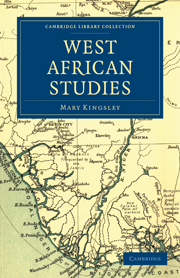Book contents
- Frontmatter
- PREFACE TO THE READER
- Contents
- LIST OF ILLUSTRATIONS
- CHAPTER I INTRODUCTORY
- CHAPTER II SIERRA LEONE AND ITS SURROUNDINGS
- CHAPTER III AFRICAN CHARACTERISTICS
- CHAPTER IV FISHING IN WEST AFRICA
- CHAPTER V FETISH
- CHAPTER VI SCHOOLS OF FETISH
- CHAPTER VII FETISH AND WITCHCRAFT
- CHAPTER VIII AFRICAN MEDICINE
- CHAPTER IX THE WITCH DOCTOR
- CHAPTER X EARLY TRADE IN WEST AFRICA
- CHAPTER XI FRENCH DISCOVERY OF WEST AFRICA
- CHAPTER XII COMMERCE IN WEST AFRICA
- CHAPTER XIII THE CROWN COLONY SYSTEM
- CHAPTER XIV THE CROWN COLONY SYSTEM IN WEST AFRICA
- CHAPTER XV MORE OF THE CROWN COLONY SYSTEM
- CHAPTER XVI THE CLASH OF CULTURES
- CHAPTER XVII AN ALTERNATIVE PLAN
- CHAPTER XVIII AFRICAN PROPERTY
- APPENDIX
- I A SHORT DESCRIPTION OF THE NATIVES OF THE NIGER COAST PROTECTORATE, WITH SOME ACCOUNT OF THEIR CUSTOMS, RELIGION, TRADE, ETC. BY M. LE COMTE C. N. DE CARDI
- II A VOYAGE TO THE AFRICAN OIL RIVERS TWENTY-FIVE YEARS AGO. BY JOHN HARFORD
- III TRADE GOODS USED IN THE EARLY TRADE WITH AFRICA AS GIVEN BY BARBOT AND OTHER WRITERS OF THE SEVENTEENTH CENTURY. BY M. H. KINGSLEY
- INDEX
- Plate section
III - TRADE GOODS USED IN THE EARLY TRADE WITH AFRICA AS GIVEN BY BARBOT AND OTHER WRITERS OF THE SEVENTEENTH CENTURY. BY M. H. KINGSLEY
Published online by Cambridge University Press: 05 December 2011
- Frontmatter
- PREFACE TO THE READER
- Contents
- LIST OF ILLUSTRATIONS
- CHAPTER I INTRODUCTORY
- CHAPTER II SIERRA LEONE AND ITS SURROUNDINGS
- CHAPTER III AFRICAN CHARACTERISTICS
- CHAPTER IV FISHING IN WEST AFRICA
- CHAPTER V FETISH
- CHAPTER VI SCHOOLS OF FETISH
- CHAPTER VII FETISH AND WITCHCRAFT
- CHAPTER VIII AFRICAN MEDICINE
- CHAPTER IX THE WITCH DOCTOR
- CHAPTER X EARLY TRADE IN WEST AFRICA
- CHAPTER XI FRENCH DISCOVERY OF WEST AFRICA
- CHAPTER XII COMMERCE IN WEST AFRICA
- CHAPTER XIII THE CROWN COLONY SYSTEM
- CHAPTER XIV THE CROWN COLONY SYSTEM IN WEST AFRICA
- CHAPTER XV MORE OF THE CROWN COLONY SYSTEM
- CHAPTER XVI THE CLASH OF CULTURES
- CHAPTER XVII AN ALTERNATIVE PLAN
- CHAPTER XVIII AFRICAN PROPERTY
- APPENDIX
- I A SHORT DESCRIPTION OF THE NATIVES OF THE NIGER COAST PROTECTORATE, WITH SOME ACCOUNT OF THEIR CUSTOMS, RELIGION, TRADE, ETC. BY M. LE COMTE C. N. DE CARDI
- II A VOYAGE TO THE AFRICAN OIL RIVERS TWENTY-FIVE YEARS AGO. BY JOHN HARFORD
- III TRADE GOODS USED IN THE EARLY TRADE WITH AFRICA AS GIVEN BY BARBOT AND OTHER WRITERS OF THE SEVENTEENTH CENTURY. BY M. H. KINGSLEY
- INDEX
- Plate section
Summary
“Those used in trade by the Senga Company of Senegal at St. Lewis and Goree and their dependent factories of Rufisco, Camina, Juala, Gamboa (Gambia), circa 1677.
“For the convenience of trade between the French at the Senega and the natives, all European goods are reduced to a certain standard, viz., hides, bars, and slaves, for the better understanding whereof I give some instances. One bar of iron is reckoned as worth 8 hides, 1 cutlace the same, 1 cluster of bugles weighing 4¼ lbs. as 3 hides, 1 bunch of false pearls 20 hides, 1 bunch of Gallet 4 hides, 1 hogshead of brandy from 150 to 160 hides. Bugles are very small glass beads, and mostly made at Venice, and sold in strings and clusters. At Goree the same goods bear not quite so good a rate, as, for example, a hogshead of brandy brings but 140 hides, 1 lb. of gunpowder 2 hides, 1 piece of eight 5 hides, 1 oz. of coral 7 or 8 hides, 1 oz. of crystal 1 hide, an ounce of yellow amber 2 hides.
“A slave costs from 12 to 14 bars of iron, and sometimes 16, at Porto d'Ali 18 to 20, and much more at Gamboa, according to the number of ships, French, English, Portuguese, and Dutch, which happen to be there at the same time. The bar of iron is rated at 6 hides.
- Type
- Chapter
- Information
- West African Studies , pp. 612 - 634Publisher: Cambridge University PressPrint publication year: 2010First published in: 1899



